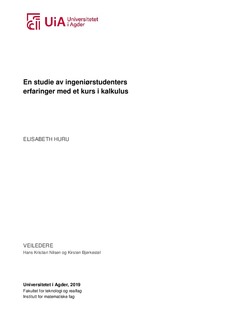| dc.description.abstract | Thisstudyis done on a group of engineering students. It was aimed at examining their experiences with a course incalculus held at their first semester. The motivation for doing this is that this course for several years has had a high failurerate. The focus will beon the students’experiences related to learningresources, as well ashow their background(both their mathematical background, but also thetransition from upper secondary schoolto university in general)influencestheir experiences of the course.The learning resources in focus islectures, group sessions, textbooks as well as a drop-in-center for guidance in mathematics found at the university.The course makes up 10 creditsofthe students first semester andgathersstudents from four different engineering educations.The selection ofthe study is the students whotook thisactual calculus course on the fall of 2018.As at theoretical framework I have started out with Biggs (1999) who points out that a great diversity among the students can make it necessary for a universityto reconsider how theirteaching is laid out, since this diversity mightgivean increased number of students that will not get sufficient learning benefits through formal lectures and group sessions. Biggs (1999) refers to Marton and Säljö (1976) who distinguishbetween a surface and a deep approachto learning, and explainsthat a great diversity among students may increase the number of students with a surface approach.For these students theformal lectures and groupsessionsmight not give a sufficient learning benefit. If the diversity among the students at the calculus coursehas increasedin later yearsis uncertain, but the findings showed a great diversity among the students’mathematical backgroundsfrom upper secondaryschool. For the collection of data,I have used mixed methods, and therefore both quantitative and qualitativeresearchmethods.Two questionnaires were used –one bythe start of the semester, and another in November, andinterviewswith nine students weremade. In the analysis the findings are presented in form of a bisection. First the findings from thequestionnairesare presented,and then the findings fromthe interviews. The findings are then collectively discussed in the discussion chapter.The interviews were shaped on the basis of the questionnaires and are meant to explain, or put words to, the number-material from the questionnaires.The study made it evident that the students mathematical background from upper secondaryhad aninfluence on how challenging they experienced the course, since students with ahigher mathematical backgroundseemed to graduallyexperience the course less challenging. Ialso found that many studentsseemed to finda value in the lectures because the teacher therewould explain the curriculum.Furthermore, through the interviews,it seemed that a great motivation for some students to attend the lectures was that they otherwise were afraid to miss out anything that might come on theirexams.As to the textbook,the data collection showed that the majority of the students used it often. However, the interviewsshowed thatseveral students found it complicated to read, and therefore, for many,it was only used to find exercises.The students couldgetguidance to exercises throughgroupsessions and in the drop-in-center. However, amongsome ofthe students that were interviewed, the opportunityto work alongwith fellow students, seemed greater than the opportunityfor guidance throughgroup sessions and the drop-in-center. | nb_NO |

